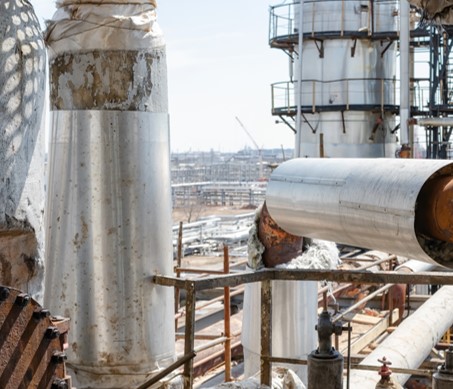Corrosion Protection in Oil and Gas Industry

Did You Know
CO2 & H2S are main corroding agents
in the oil and gas production systems
Corrosion is one of the biggest problems faced by maintenance engineers in the Oil and Gas industry and a potential hazard for production and transportation facilities. Crude oil and natural gas contain carbon dioxide (CO2), hydrogen sulfide (H2S), and free water which are inherently corrosive. Continuous extraction of CO2, H2S, and free water through oil and gas components, corrode the internal surfaces of these components and the lines and component fittings would undergo material de-gradations resulting in the loss of mechanical properties like strength, ductility, etc. which leads to the loss of materials, reduction in thickness, and at times ultimate failure. As a result of corrosion, a component may completely break down and the assembly will need to be replaced disrupting production and causing severe economic losses.
Daubert VCI-based anti-corrosion products
are designed to work with
downstream and upstream processes
Daubert CCI & SACI technologies
based products have approvals
in many applications
Some oil companies face pipeline ruptures due to corrosion and oil spillages, while resources are lost in cleaning up this environmental mess, catastrophic ecological damages take place as a result of corrosion which often lingers on for decades.
Corrosion in oil and gas industry
Sweet corrosion (CO2corrosion) :
CO2 is one of the main corroding agents in oil and gas production systems. Dry CO2 gas is not itself corrosive but when dissolved in the aqueous phase, undergoes an electrochemical reaction with steel and the contacting aqueous phase. CO2 will mix with water, form carbonic acid making the fluid acidic.
CO2 corrosion can appear mainly in two forms: pitting (a localized attack that results in rapid penetration and removal of metal at a small discrete area) and mesa attack (a form of localized CO2 corrosion under medium-flow conditions).
H2S corrosion in oil and gas production (Sour corrosion) :
H2S corrosion is one of the most challenged corrosion issues in the oil and gas production industry. H2S is an excessively aggressive gas that accompanies reservoir brooks while removing hydrocarbons from the ground. The corrosion attributable to H2S cracks by its immense destructing force to equipments and infrastructure.
The deterioration of metal due to contact with hydrogen sulfide (H2S) and moisture is called sour corrosion which is the most damaging to drill pipes. H2S is not corrosive in itself but when dissolved in water forms an acid and becomes corrosive, leading to pipeline embrittlement.
The forms of sour corrosion are uniform, pitting, and stepwise cracking.
Oxygen corrosion :
Oxygen is a strong oxidant and reacts with the metal very quickly. Oxygen dissolved in drilling fluids is a major cause of drill pipe corrosion. Oxygen ingress takes place in good fluids through leaking pump seals, casing, and process vents and open hatches. The high-velocity flow of drilling fluids over the surfaces of a drill pipe continues to supply oxygen to the metal and the presence of oxygen magnifies the corrosive effects of the acidic gases (CO2 and H2S). The inhibition of corrosion promoted by oxygen is difficult to achieve and is not practical in the drilling fluid system.
The forms of corrosion associated with oxygen are mainly uniform corrosion and pitting-type corrosion.
Galvanic corrosion :
This type of corrosion occurs when two metallic materials with different nobilities (electrochemical potential) are in contact and are exposed to an electrolytic environment. In such a situation, the metal with less or the most negative potential becomes the anode and starts corroding. The anode loses metal ions to balance the electron flow.
Crevice corrosion :
Crevice corrosion is normally localized corrosion taking place in the narrow clearances or crevices in the metal and the fluid getting stagnant in the gap. Electrochemical potential differences and oxygen dissolved in drilling fluid promote crevice corrosion.
Erosion corrosion :
The erosion-corrosion mechanism increases the corrosion reaction rate by continuously removing the passive layer of corrosion products from the wall of the pipe. The passive layer is a thin film of corrosion products that serve to stabilize the corrosion reaction and slow it down. As a result of the turbulence and high shear stress in the line, this passive layer can be removed, causing the corrosion rate to increase. High velocities and the presence of abrasive suspended material and the corrodents in drilling and produced fluids contribute to this destructive process.
Microbiologically induced corrosion :
This type of corrosion is caused by bacterial activities. The bacteria produce waste products like CO2, H2S, and organic acids that corrode the pipes by increasing the toxicity of the flowing fluid in the pipeline. The microbes tend to form colonies in a hospitable environment and allow enhanced corrosion under the colony. The formation of these colonies is promoted by neutral water especially when stagnant.
Microbiologically induced corrosion (MIC) is recognized by the appearance of black slimy waste material or nodules on the pipe surface as well as the pitting of the pipe wall underneath these deposits.
Stress corrosion cracking :
Stress corrosion cracking (SCC) is a form of localized corrosion that produces cracks in metals due to the simultaneous action of corrodent and tensile stress. The most obvious identifying characteristic of SCC in a pipeline is the high pH of the surrounding environment, the appearance of patches, or colonies of parallel cracks on the external surface of the pipe.
Typical equipment requiring preservation :
- Process vessels and tanks
- Turbines
- Electrical control panel
- Pressure vessel
- Pipes & valves
- Heat exchangers
- Pumps
- Compressors
- Drill pipes & collars
- Fuel oil tanks
- Hydraulic oil & lubricating oil system
- Electrical equipment
- Diesel engine
- Cooling towers
- Gearboxes & speed changers
Corrosion prevention in the oil and gas industry :
Oil field corrosion challenges are not static phenomena. Fluid characteristics change over time, resulting in systems becoming less responsive to established corrosion prevention methods. Followings are the methods advised for corrosion prevention in Oil & Gas sector:
- Selection of appropriate materials
- Use of inhibitors
- Use of protective coatings
- Adequate corrosion monitoring and inspection
- Cathodic protection technique
Selection of appropriate materials :
When it is observed that the existing materials of construction are prone to corrosive attack, it is normally decided to change the materials of construction and select alternate materials to suit the specific need. Stainless steels cover a wide range of alloys, each with a particular combination of corrosion resistance and mechanical properties. Oil and gas equipment last longer when both inhibitors and protective coatings are used together.
Use of inhibitors :
Inhibitors are chemicals that are used to protect the surface of metals used in oil and gas industries to prevent corrosion. A corrosion inhibitor may act in several ways: It may restrict the rate of the anodic process or the cathodic process by simply blocking active sites on the metal surface. A further mode of action of some inhibitors is that the inhibiting compound contributes to the formation of a thin layer on the surface which stifles the corrosion process.
VCI is an environmentally safe and cost-effective option for Corrosion Protection. VCIs form a physical bond on the metal surface and create a barrier layer to protect against aggressive ions. The barrier re-heals and self-replenishes and can be combined with other protective coatings. It can be used in pipelines, oil and gas wells, refinery units, and fuels. In addition, these proprietary Daubert VCI-based anti-corrosion products are designed to work in presence of moisture.
Use of protective coatings :
A protective layer or barrier on the material to avoid direct contact with the process media will enhance the material and equipment life. The barrier layer can be painted, a coating or a lining, or a metallic lining or metallic sheets. There are also non-metallic linings like fibreglass, glass flake, epoxy, and rubber which are normally carried out on the equipment like separators, knock-out drums, and storage tanks. Coatings based on Daubert CCI (Contact Corrosion Inhibition) & SACI (Severe Atmospheric Corrosion Inhibitors) technologies have been found to be very useful by several important players in this field.
Adequate corrosion monitoring and inspection :
Corrosion monitoring is the practice of measuring the corrosivity of process stream conditions by the use of probes (mechanical, electrical, or electrochemical devices) that are inserted into the process stream and continuously exposed to the process stream condition. Corrosion monitoring techniques alone provide a direct and online measurement of metal loss/corrosion rate in oil and process systems. However, the best way to check corrosion is by visual inspection and checking up the material degradation periodically.
Recommended Additional Reads




